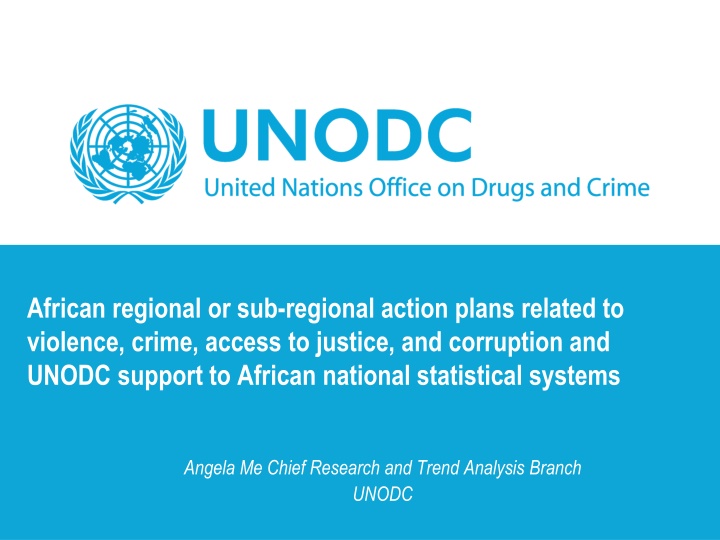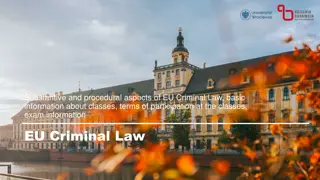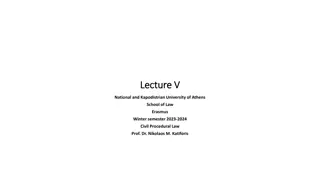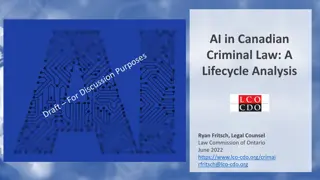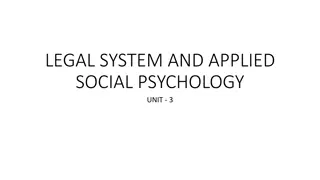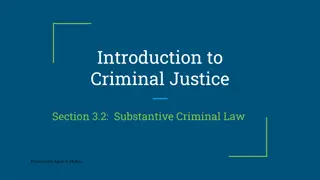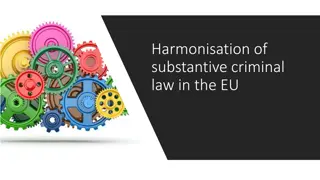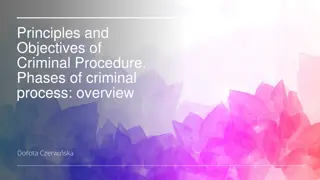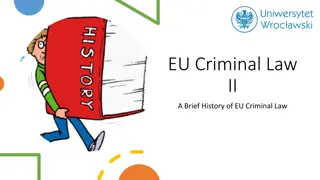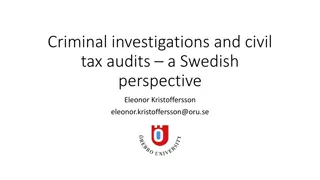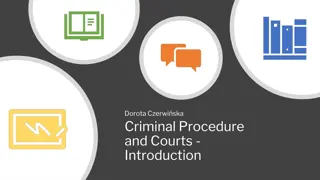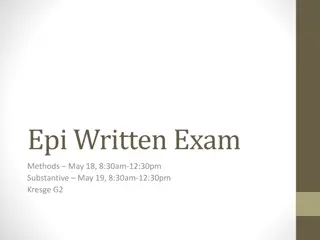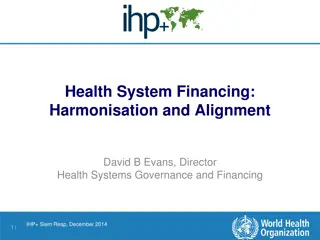Harmonisation of Substantive Criminal Law in the EU and Data Protection
This article discusses the Directive 2017/541 which establishes rules on criminal offences, sanctions, and protection of victims in the area of terrorist activities within the EU. It defines terrorist groups, offences, and aims related to terrorism. The Directive aims to combat terrorism effectively and ensure harmonisation across Member States.
Download Presentation

Please find below an Image/Link to download the presentation.
The content on the website is provided AS IS for your information and personal use only. It may not be sold, licensed, or shared on other websites without obtaining consent from the author.If you encounter any issues during the download, it is possible that the publisher has removed the file from their server.
You are allowed to download the files provided on this website for personal or commercial use, subject to the condition that they are used lawfully. All files are the property of their respective owners.
The content on the website is provided AS IS for your information and personal use only. It may not be sold, licensed, or shared on other websites without obtaining consent from the author.
E N D
Presentation Transcript
African regional or sub-regional action plans related to violence, crime, access to justice, and corruption and UNODC support to African national statistical systems Angela Me Chief Research and Trend Analysis Branch UNODC
RoL and access to justice Violence and violent deaths Affordable, timely access to independent court/unbiased justice Peaceful resolutions of conflict, culture of peace, security, safety Prevention and treatment of drug abuse Drug free Violence against women and girls SDG Gender based violence A2063
Corruption Corruption Human trafficking Human trafficking Organized crime Organized crime Firearms Firearms trafficking trafficking
Illicit Financial Flows Violence against children Wildlife trafficking Piracy Urban safety Terrorism, extremism
Effective criminal justice systems to combat organized crime, drug trafficking and drug use Effective suppression and international cooperation against organizations involved in organized crime, drug trafficking and consumption ESCWA and AU Plan of Action ESCWA and AU Plan of Action Access to controlled drugs for medical purposes Drug use and prevention, services to address health and social impact of drug use Sustainable, valid and reliable data on drug consumption, drug trafficking and organized rime Reduction od drug trafficking
Spill over effect of drug trafficking is a major concern in Africa
The data needed Recorded violent crime (homicide) Exposure to justice systems (surveys among general population, in prison) Unreported violence, corruption, safety perception (victimization surveys) Records in criminal justice institutions Seizures, detected victims Drug use surveys, drug treatment information system
The actors Police Ministry of Justice NSO Coordinating role of the NSO Ministry of health Prison administration Drug control agencies
Typical UNODC Support Assessment of crime and criminal justice statistics National Coordination International Classification of Crime for Statistical Purposes (ICCS) National surveys Example of Nigeria Standards to undertake victimization surveys Improvement of accessibility to and public dissemination of available data on crime and criminal justice
Challenges in using crime statistics Three main factors affect interpretability of crime statistics (i.e. what to account for when making sense of figures on crimes): Proportion of crime that is reported/detected The way crime is defined and classified What is addressed by the ICCS? The way crime is recorded and counted
Improve measurability and analysis of crime The ICCS: a hierarchical framework that groups and organizes criminal offences meaningfully and systematically. It allows to: o Build a comprehensive stat. framework on all criminal offences to facilitate analysis of crime o Improve comparability across countries and through time o Improve data consistency within countries: across entities in federal states across data produced by successive stages of criminal justice process across sources (admin. data and surveys)
Principles Object of the classification: the primary unit of classification is the act or event which constitutes a criminal offence The description of criminal acts is based on behaviours/events, not on legal provisions or terms Statistical Principles: Exhaustiveness events generally known to constitute offences in a significant number of countries Structure organised hierarchically, with manageable and balanced numbers of categories at successive levels Mutual exclusivity any crime assigned to one and only one category Description as precise as possible description of each criminal act and category
Additional attributes Additional attributes Disaggregating variables: Event descriptions: Use of weapon, location, organised crime, attempted/completed Victim descriptions: natural person (age, sex, age status, citizenship), legal entity/business (economic sector), public entity Perpetrator descriptions: ages, sex, age status, citizenship, victim- perpetrator relationship Data descriptions (Metadata): Inclusion of threats, aiding, accomplice, conspiracy, incitament
The current structure The current structure of the ICCS of the ICCS 11 Top-level categories: Categories for Level 1 (Sections) Acts leading to death or intending to cause death Acts leading to harm or intending to cause harm to the person Injurious acts of a sexual nature Acts against property involving violence or threat against a person Acts against property only Acts involving controlled psycho-active substances or other drugs Acts involving fraud, deception or corruption Acts against public order, authority, and provisions of the State Acts against public safety and state security Acts against the natural environment Other criminal acts not elsewhere classified 01 02 03 04 05 06 07 08 09 10 11
Clarifying intentional homicide Clarifying intentional homicide
Thank you for your attention
